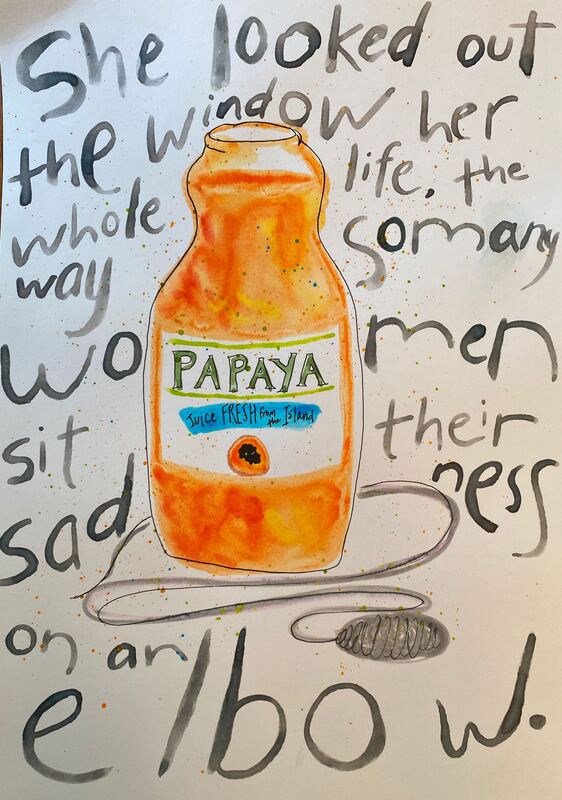Artistic Genre: Papaya Juice Painting
This piece is a mixed media drawing that uses watercolor paints and ink to depict a bottle of papaya juice surrounded by the text, “She looked out the window her whole life, the way so many women sit their sadness on an elbow,” which comes from Esperanza’s description of her grandmother, from whom she got her name. To link this mournful description of a woman from an earlier generation to the many younger women who appear in Esperanza’s story, I paired this quote with a bottle of papaya juice, one that Rafaela might drink on a Tuesday when she lifts juice bottles to her apartment window via a silver string because her husband has locked her indoors because she is too beautiful. Although I did not realize it during my first reading of The House on Mango Street, women throughout the neighborhood are characterized by their relationship to looking out windows. Rafaella is “still young but getting old from learning out the window so much” (p. 79); Mamacita “sits all day by the window and plays the Spanish radio show” (p. 77); Sally spends her day looking at the things inside her home because her husband “doesn’t let her look out the window” (p. 102). This is not an exhaustive list.
Windows seem to symbolize a connection to the outside world that women must settle for and figure out how to use because of their limited position in a patriarchal society. Through my piece, I wanted to capture through color a sense of tantalizing vibrancy that comes through the window to Rafaella, a taste of the sweetness of a world in which she is the agent of her life. Additionally, I referenced “the island” that Rafaella longs for, as well, which I interpreted as Puerto Rico, perhaps Rafaella’s home. However, Rafaella’s window, one which bars her from fully participating in society, is contrasted with Esperanza’s willful determination to refuse to settle for a mere window, but to own a whole house for herself. She says, “Not a flat. Not an apartment in the back. Not a man’s house. Not a daddy’s. A house all my own” (p. 108). For women in The House on Mango Street, belonging looks like longing to and transcending of the roles in which they have be relegated—told to “belong.” Then, they truly belong to themselves and their own space in the world.
Windows seem to symbolize a connection to the outside world that women must settle for and figure out how to use because of their limited position in a patriarchal society. Through my piece, I wanted to capture through color a sense of tantalizing vibrancy that comes through the window to Rafaella, a taste of the sweetness of a world in which she is the agent of her life. Additionally, I referenced “the island” that Rafaella longs for, as well, which I interpreted as Puerto Rico, perhaps Rafaella’s home. However, Rafaella’s window, one which bars her from fully participating in society, is contrasted with Esperanza’s willful determination to refuse to settle for a mere window, but to own a whole house for herself. She says, “Not a flat. Not an apartment in the back. Not a man’s house. Not a daddy’s. A house all my own” (p. 108). For women in The House on Mango Street, belonging looks like longing to and transcending of the roles in which they have be relegated—told to “belong.” Then, they truly belong to themselves and their own space in the world.

